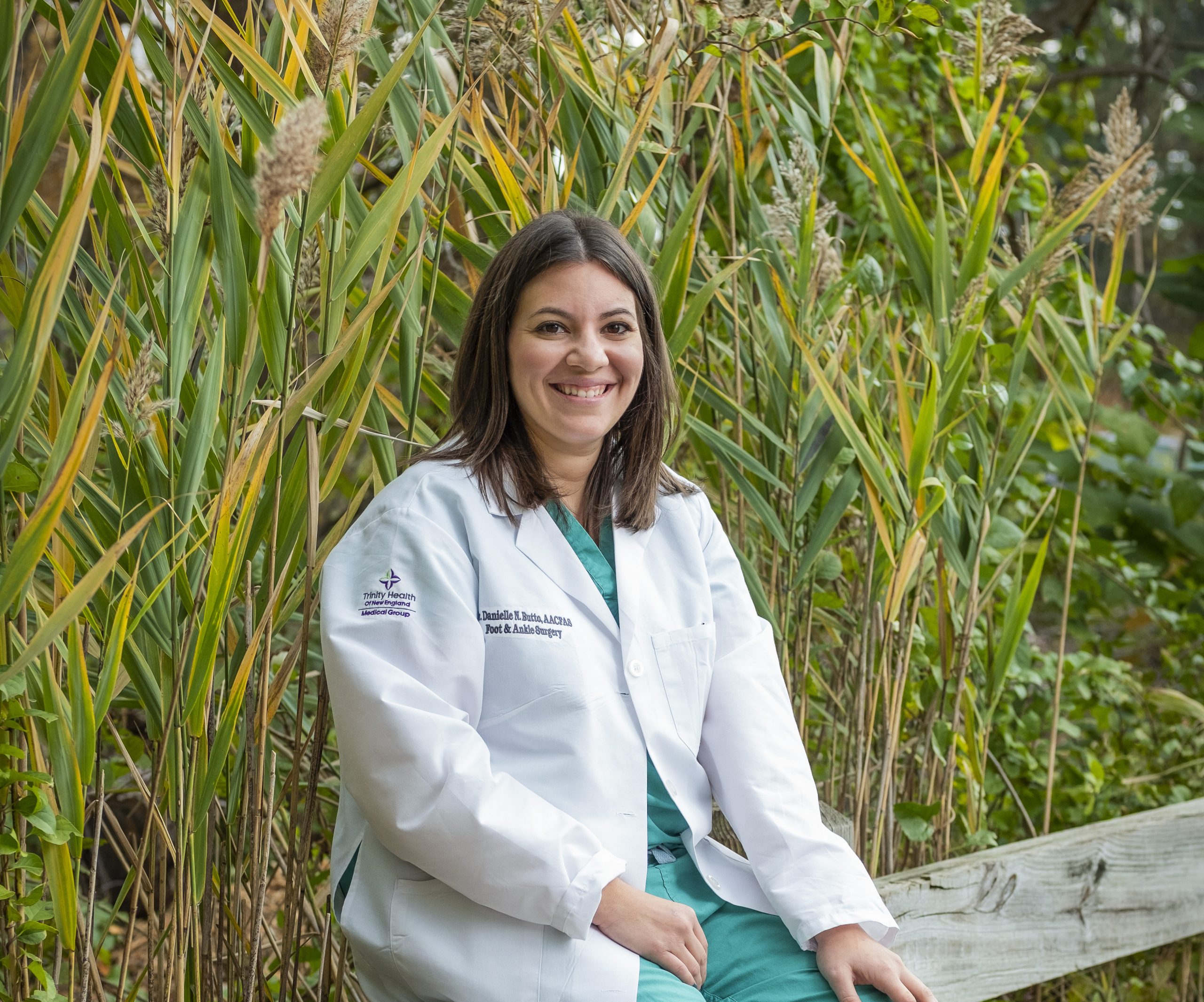Saint Francis podiatrist Danielle Butto, who graduated from the University of Akron with a Bachelors of Science in Civil Engineering, says there are a lot of similarities between civil engineering and podiatry, particularly when it comes to reconstructive surgery of the foot and ankle, Dr. Butto’s specialty.
“When someone has a deformity – or has suffered a trauma – and you are looking to rebuild the lower leg, you have to consider a lot of the same concepts that would go into constructing a column for a building,” Dr. Butto explains. “You have to think about how the foot is going to support weight, you have to think about alignment, and you have to figure out where to put a screw to withstand forces from walking, and what type of plating system can hold it all together.”
Civil engineering was Dr. Butto’s back-up plan: She had always wanted to go into medicine, but her mother advised her to get an undergraduate degree in something she could do in case she changed her mind. She didn’t. She was a junior in her engineering program when she reached out to a podiatrist in nearby Youngstown and asked to shadow him for a week. “I didn’t know it at the time, but he was considered one of the best reconstructive surgeons in the profession.” After that auspicious introduction to the field, she decided to pursue podiatry as a profession. Almost a decade later, Dr. Lawrence DiDomenico, the foot specialist she randomly chose to shadow, would become her fellowship director.
A native of Ohio, Dr. Butto grew up in Niles, about an hour from Cleveland. She remained in the Midwest for her medical training at Des Moines University College of Osteopathic Medicine, came to the East Coast to complete a three-year surgical residency at Saint Francis Hospital and Medical Center, and returned to Ohio to do a fellowship in Reconstructive Rearfoot and Ankle Surgery under Dr. DiDomenico. She was invited back to Saint Francis by her current partner, Dr. Rachel Balloch, who trained her as a resident. She joined the hospital’s staff in 2016.
RECONSTRUCTING THE FOOT
During her fellowship training, Dr. Butto became skilled in performing the intricate surgery required to reconstruct the foot and ankle following trauma or in individuals who suffer from a condition known as Charcot foot. “Charcot is a disease process where the bones break down and deform,” explains Dr. Butto. “It tends to happen in people who have neuropathy – or nerve damage – in their feet, possibly because if they misstep and fracture a bone, they can’t feel it, so continue to walk on it, and the bone deforms.”
Neuropathy – and Charcot – often occur in people who have diabetes. “I think we are seeing more and more of it because diabetes is becoming more and more prevalent,” notes Dr. Butto. Neuropathy can also develop as a result of chemotherapy, some autoimmune disorders, and drug use.
Reconstructing the foot usually involves the placing of screws and plates, Dr. Butto says, so her background in engineering comes in handy. In fact, Dr. Butto helped design a new device for this purpose that will soon be added to the foot surgeon’s arsenal.
Dr. Butto is often called on to correct other common foot deformities like flat foot, high arch, and bunion, all conditions that people are either born with – or born with a genetic predisposition to. People with flat feet often experience knee pain, Dr. Butto says, as insufficient arches cause instability of the midfoot. People with flat feet also tend to pronate; that is, they put most of their weight on the insides of their feet as they walk or run, which puts excess stress on the knee.
Conversely, those with high arches supinate, or walk with most of their weight on the outside of their feet, exerting undue stress on the outside ankle joint and causing ankle instability. In fact, people with high arches tend to sprain their ankles more easily. “The initial treatment is the same for both problems,” says Dr. Butto. “An orthotic to realign the foot, and physical therapy.” Severe cases, however, may require surgical intervention.
Bunions, which often develop in people with hypermobile joints or flat feet, are bony – and sometimes painful – protrusions on the inside of the foot. The classic bump, which juts out just below the big toe, develops after years of abnormal movement and pressure on the joint. Wearing orthotics can help support that midfoot joint, says Dr. Butto, and she doesn’t resort to surgery unless the bunion is causing pain and interfering with everyday activities. “Unless you can say yes to both of those conditions, you adapt your shoe gear,” she says. “Once it becomes painful, you address correcting it.”
Though there are several different possible procedures, Dr. Butto most commonly performs what is called a “Lapidus Bunionectomy,” an operation that realigns the bone to where it should be and fuses it into place. This procedure usually requires about six weeks of recovery – Dr. Butto advises her patients to stay off the foot for two weeks and then transition to a boot and, ultimately, a sneaker. Patients with osteoporosis, who aren’t candidates for this procedure, can have the bump surgically shaved down, which eliminates the pain, but not the underlying abnormalities that are causing the bunion, so recurrence is a possibility.
For bunions that are caused by arthritis in the big toe, a relatively new procedure that is less painful, less invasive, and requires less recovery time, replaces the big toe joint with a synthetic cartilage implant called Cartiva. Though the implant is FDA-approved and Dr. Butto will only do this procedure in the right patients, she says doctors don’t yet have any long-term data on these implants, because they are too new.
SALVAGING THE FOOT, RESTORING MOBILITY
Limb salvage is another special interest of Dr. Butto’s. Diabetics can develop vascular disorders and ulcers that lead to infections in their lower extremities; Charcot can also lead to foot ulcers and limb-threatening infections. In these patients, below-the-knee amputation is often a consideration. “It becomes a challenge to save the foot, but I like that challenge,” she says. Treatment can involve special wound dressing, wound grafts, or surgery. Dr. Butto says she often works with the hospital’s vascular and plastic surgeons to find the best way to remove infected tissue while preserving the function and aesthetic appearance of the foot.
One of the most rewarding parts of Dr. Butto’s job, she says, is restoring mobility to patients who come to her unable to walk. A recent patient, age 53, came to her in a wheelchair, with a foot so deformed by severe Charcot that he couldn’t even get a shoe on, much less walk.
“We reconstructed his foot, which was literally turned in, and held it in place with screws and plates,” she says. “Now he can walk again; in fact, he walked into my office last week, wearing a custom shoe. Those are my feel-good days, when you know you made a difference in someone’s life.”
She says she is more likely to be able to help patients if they don’t wait too long to come in to see her: “The longer you are walking on a deformed foot, the harder it becomes to correct,” she explains. “I think that people are afraid that if they come in, we are automatically talking surgery, but that is not always the case. For me, surgery is always the last thing we talk about.”
On Dr. Butto’s desk – along with the binder that corrals the extensive research she has done on podiatric procedures, protocols and devices – is an eclectic array of objects, ranging from a large purple geode, to a clock that survived the hurricane in Puerto Rico, to hand-drawn pictures created by some of her pediatric patients.
“I display every gift a patient has ever given me,” says Dr. Butto, “as a reminder of why I do what I do and how people are appreciative in their own ways because of it.”
Lori Miller Kase is a freelance writer living in Simsbury.
Seshu’s Connecticut Headshots helps business leaders and actors make an impression, so that they can make a lasting impact.







More Stories
Jamie Shawver, D.O.: The Modern-Day Family Doctor
Leading in Urologic Oncology: Ryan Dorin, M.D., Works on Expanding Patient Care
UConn Health Stands at the Forefront of Comprehensive Sickle Cell Treatment in the U.S.